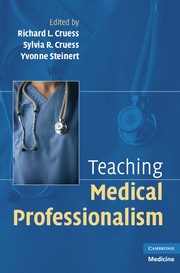Book contents
- Frontmatter
- Contents
- List of Contributors
- Foreword by William M. Sullivan
- Introduction
- PART ONE WHAT IS TO BE TAUGHT
- PART TWO THEORY
- 2 Educational Theory and Strategies for Teaching and Learning Professionalism
- 3 Professionalism and the Socialization of Medical Students
- PART THREE PRINCIPLES
- PART FOUR PRACTICE: CASE STUDIES IN TEACHING PROFESSIONALISM ACROSS THE CONTINUUM
- APPENDIX A Definitions of Professionalism
- APPENDIX B Core Attributes of Professionalism
- APPENDIX C The Teaching of Professionalism: Vignettes for Discussion
- APPENDIX D A Matrix for “Matching” Teaching Methods to Attributes
- APPENDIX E Sample Grid for Use with Discussion of Vignettes
- APPENDIX F Sample Questions to Guide Discussion about the Social Contract: Small-Group Leaders' Guide with Suggested Responses
- APPENDIX G Professionalism Program for Residents: Suggested Outline for Small Group Facilitators
- APPENDIX H Sample Evaluation Form for Residents' Half-Day Program on Professionalism
- Index
- References
2 - Educational Theory and Strategies for Teaching and Learning Professionalism
Published online by Cambridge University Press: 01 September 2009
- Frontmatter
- Contents
- List of Contributors
- Foreword by William M. Sullivan
- Introduction
- PART ONE WHAT IS TO BE TAUGHT
- PART TWO THEORY
- 2 Educational Theory and Strategies for Teaching and Learning Professionalism
- 3 Professionalism and the Socialization of Medical Students
- PART THREE PRINCIPLES
- PART FOUR PRACTICE: CASE STUDIES IN TEACHING PROFESSIONALISM ACROSS THE CONTINUUM
- APPENDIX A Definitions of Professionalism
- APPENDIX B Core Attributes of Professionalism
- APPENDIX C The Teaching of Professionalism: Vignettes for Discussion
- APPENDIX D A Matrix for “Matching” Teaching Methods to Attributes
- APPENDIX E Sample Grid for Use with Discussion of Vignettes
- APPENDIX F Sample Questions to Guide Discussion about the Social Contract: Small-Group Leaders' Guide with Suggested Responses
- APPENDIX G Professionalism Program for Residents: Suggested Outline for Small Group Facilitators
- APPENDIX H Sample Evaluation Form for Residents' Half-Day Program on Professionalism
- Index
- References
Summary
There is nothing so practical as a good theory.
As the chapters in this book demonstrate, professionalism is taught and learned in diverse and complex ways. Indeed, the past decade has witnessed a significant increase in the teaching and learning of professionalism in undergraduate and postgraduate medical education. However, despite this rapid growth, few authors have described the educational frameworks that underpin their work in this area, even though we all hold different assumptions about what we teach and how we try to achieve our goals.
For example, one contemporary school of thought has emphasized that professionalism needs to be taught explicitly, either by defining core content or outlining professionalism as a list of traits or characteristics. From this perspective, the goal is to ensure that every physician understands the nature of professionalism, its basis in morality, the reasons for its existence, its characteristics, and the obligations necessary to sustain it. Others have stated that the teaching of professionalism should be approached primarily as a moral endeavor, emphasizing altruism and service, the importance of role modeling, self-awareness, community service, and other methods of acquiring experiential knowledge. In this school of thought, explicit teaching receives less attention, and learning is embedded in an authentic activity. Although both approaches are needed to promote the teaching and learning of professionalism, as teachers and educators we must clarify the assumptions that we hold and try to answer the following question: What is our guiding theory or educational framework?
- Type
- Chapter
- Information
- Teaching Medical Professionalism , pp. 31 - 52Publisher: Cambridge University PressPrint publication year: 2008
References
- 1
- Cited by



